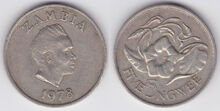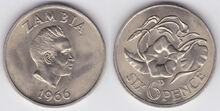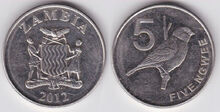| 5 ngwee | |
|---|---|

| |
| 2012 coin | |
| General information | |
| Country | |
| Value |
0.05 kwacha |
| Years |
1968–present |
| Measurements and composition | |
| Mass |
|
| Diameter |
|
| Thickness |
|
| Composition |
|
| Appearance | |
| Shape |
round |
| Alignment |
medallic |
| Edge |
|
| Obverse |
|
| Reverse |
|
| v · d · e | |
The 5 ngwee coin is a current circulation coin of the Republic of Zambia, issued in two types since 1968. With the introduction of the first kwacha in 1968, the first coin of the denomination was struck that year. The piece was then produced intermittently until 1987, when high inflation rendered it virtually obsolete. In 2013, following the rebasing of the kwacha, a new 5 ngwee piece (dated 2012) made its début, and has been minted annually since.
As part of the rebased kwacha, the second 5 ngwee coin currently holds a legal tender face value equivalent to 0.05 kwacha. While the piece of the beleaguered initial currency is still considered legal tender, it has disappeared from circulation due to its low face value. With 1,000 old kwacha equaling 1 new kwacha, the 5 ngwee coin of the former currency has a value of only 0.00005 new kwacha. Both pieces were distributed by the Bank of Zambia (BoZ) and produced at foreign mints.
Coins[]
Coin of the first kwacha (1968–1987)[]
- See also: Zambian 6 pence coin

1978 coin
In response to social pressures in Rhodesia and Nyasaland, the United Kingdom granted independence to its protectorate of Northern Rhodesia in 1964. The country was subsequently renamed to the Republic of Zambia, and Prime Minister Kenneth Kaunda (1924–) was installed as its first President.
Shortly after gaining independence, Zambia in 1964 introduced its own pound to replace the earlier currency of Rhodesia and Nyasaland. However, a few years later, in 1968, the decimalized first kwacha was introduced, replacing the pound at a rate of 2 kwacha = 1 pound (or 1 kwacha = 10 shillings). The Bank of Zambia contracted the British Royal Mint to strike the first series of coins for the new currency, which consisted of denominations of 1, 2, 5, 10, and 20 ngwee. All were designed by English sculptor Norman Sillman (1921–2013). Of the pieces, the 5 ngwee coin was struck intermittently from 1968 until 1987.
The initial 5 ngwee coin is composed of a cupronickel alloy, weighs approximately 2.8 grams, and measures 19.4 millimeters in diameter and 1.38 millimeters in thickness. It has medallic alignment and a reeded edge, and like most coins, is round in shape. The rims of both the obverse and reverse are raised and undecorated.

A 1966 6 pence, very similar in design to the 5 ngwee coin
The designs of the obverse and reverse are very similar to those of the 1966 Zambian sixpence. Such a coin, valued at 0.025 pre-decimal pounds, could be exchanged for 5 ngwee during the transition to the kwacha in 1968. Displayed in the center of the obverse is a right-facing bust of President Kenneth Kaunda. "ZAMBIA" is inscribed clockwise along the rim above Kaunda's likeness, and the Gregorian date of minting is written in the opposite direction around the periphery below.
Engraved at the top center of the reverse is a morning glory (Ipomoea), a type of flowering plant native to Zambia and several other locations worldwide. The numeral "5", identifying the face value of the piece, is printed horizontally below the plant. It is accompanied by the inscription "FIVE NGWEE", which appears counterclockwise along the coin's bottom periphery. The two words are separated by the "5", which is more than twice as large as the text.
A total of approximately 45,004,000 examples of the first 5 ngwee coin were produced over five years from 1968 to 1987, including 44,976,000 business strikes and 28,000 proofs. Business strikes were minted in 1968, 1972, 1978, 1982, and 1987, whereas proofs were produced solely in 1968 and 1978 as components of exclusive proof sets. Additionally, an unknown number of pieces dated 1968 were included in mint sets.
| Mintages | |
|---|---|
| Year | Mintage |
| 1968 | 12,000,000 |
| 1968 Proof | 4,000 |
| 1972 | 9,000,000 |
| 1978 | 1,976,000 |
| 1978 Proof | 24,000 |
| 1982 | 12,000,000 |
| 1987 | 10,000,000 |
| Total | 45,004,000 |
Coin of the rebased kwacha (2012–present)[]

2012 coin
Due to inflation, the Zambian kwacha lost a considerable amount of its value from 1989 to the early 2000s. In response to this issue, in 2012 the Board of the Bank of Zambia recommended rebasing the kwacha. The initiative was authorized by the Zambian government on January 23 of the same year, and consequently the BoZ set a changeover date for the new kwacha to January 1, 2013. During July 2012, the BoZ contracted the South African Mint in Pretoria to produce a series of coins in denominations of 5, 10, and 50 ngwee, and 1 kwacha for the rebased currency. Such pieces, along with new banknotes, were unveiled by Minister of Finance Alexander Chikwanda (1938–) and BoZ Governor Michael Gondwe at a ceremony on December 31, 2012, and entered circulation as planned on the following day. Of the coins, the 5 ngwee (pictured above) has been struck annually since 2012.
The 5 ngwee piece is composed of nickel-plated steel, weighs 2.5 grams, and measures 19 millimeters in diameter and 1.55 millimeters in thickness. The coin has medallic alignment and a plain edge, and is round in shape. The rims of both the obverse and reverse are raised and undecorated.
Featured in the middle of the obverse is the coat of arms of Zambia – which consists of a central escutcheon decorated with wavy lines, supported by a Zambian man in Western attire and a woman in traditional garb, both standing on green earth. Buildings, a plains zebra (Equus quagga), and an ear of corn (Zea mays) are additionally included on the green earth, and a scroll bearing the national motto "ONE ZAMBIA ONE NATION" is displayed below. Surmounting the escutcheon in the arms are a crossing pickaxe and hoe, and an African fish eagle (Haliaeetus vocifer).
The state title "ZAMBIA" is inscribed above the arms on the coin, appearing clockwise along the upper rim. Printed in Western Arabic numerals below the arms is the Gregorian date of minting, which travels counterclockwise along the coin's lower boundary. Displayed in the center of the reverse is an illustration of a Zambezi indigobird (Vidua codringtoni), a species of bird native to parts of Zambia, perched on a branch and facing right. A large numeral "5", representing the piece's face value, is written to the upper left of the illustration. "FIVE NGWEE" is engraved along the lower right boundary of the coin, extending in a counterclockwise direction from the bottom rim to the upper right.
The total mintage of the second 5 ngwee coin is currently unknown. Only business strikes are known to have been produced.
| Years |
|---|
|
References[]
- Numismatic Guaranty Corporation – 1968-1987 Zambia 5 Ngwee KM# 11
- Numista – 6 Pence (1966), 5 Ngwee (1968-1987), 5 Ngwee (2012-present)
- Lusaka Times – SA company to mint new Zambian coins
- Bank of Zambia – Currency Rebasing Technical Guidelines
- Africa Review – Zambia unveils redenominated currency
Zambian kwacha on the English Wikipedia
| Zambian kwacha | |
|---|---|
| Banknotes | Current: 2 K • 5 K • 10 K • 20 K • 50 K • 100 K Former: 50 n • 1 K • 2 K • 5 K • 10 K • 20 K • 50 K • 100 K • 500 K • 1,000 K • 5,000 K • 10,000 K • 20,000 K • 50,000 K |
| Coins | Current: 5 n • 10 n • 50 n • 1 K Former: 1 n • 2 n • 5 n • 10 n • 20 n • 25 n • 50 n • 1 K • 5 K • 10 K • 20 K • 75 K • 100 K • 200 K • 250 K • 500 K • 1,000 K • 2,000 K • 2,500 K • 4,000 K • 5,000 K • 10,000 K • 20,000 K • 25,000 K • 40,000 K • 50,000 K • 100,000 K • 500,000 K |
| Miscellaneous | Bank of Zambia • De La Rue • Kwacha • Ngwee • Rebasing • Zambian pound |
